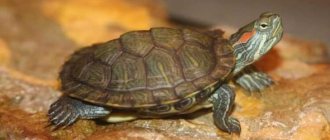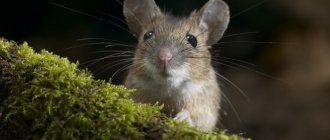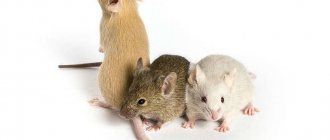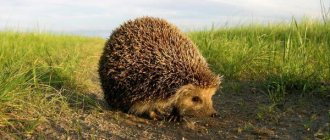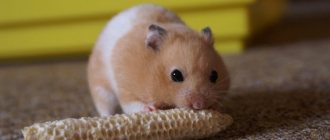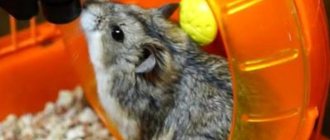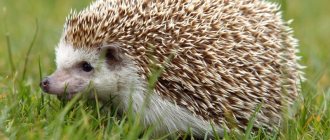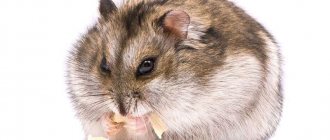Mice are small animals belonging to the class of mammals, an order of rodents from the mouse family.
They are found everywhere. The vast majority of their species live in tropical and subtropical forests, with fewer in the temperate and northern latitudes of Europe and Asia, as well as on the Australian mainland. There are approximately 13 species of mice common in the Russian Federation.
In total, the mouse family list includes 147 genera and 700 species. The size of the animal ranges from 5-48 cm, depending on the type of animal.
Below in the article we will try to describe what types of mice there are, how many species of them are found in Russia, what types of mice live where, and also provide their names, descriptions and photos.
Baby mice
They are one of the smallest rodents on earth. The size of an adult does not exceed 7 cm, the tail - 6-7 cm. The baby weighs no more than 10 g.
The appearance of the animal, namely its coloring, distinguishes it from other species. The fur of these mice is bright red in color, except for the abdomen, which is almost white.
Habitat: Spain, Korea, Japan, southern Kazakhstan, China and northern Mongolia. They are found in forests, fields and forest-steppe. In the summer they build nests in the grass, and in the winter they move into burrows, haystacks, and human dwellings.
Baby mice quickly adapt to their new environment. They are quite peaceful and calm. They can live in captivity. At the same time, the animals need a large, capacious cage or a small terrarium so that the little ones can move and climb freely.
In food, it prefers seeds, cereals, legumes, and small insects.
Features of character and lifestyle
Photo: Vole mouse in nature
Field mice are fussy and voracious creatures. The mouse's body temperature ranges from 37.5°C to 39°C. In order to maintain it, animals need to be active around the clock and all year round and consume a lot of food. If a mouse stops moving in winter, it will freeze; if it stops moving in summer, it may die from excess heat. The entire life of a mouse is spent in motion - foraging for food, eating, mating games, giving birth to offspring and caring for them.
Daily activity changes throughout the year: in summer - at night, in autumn - day and night, in winter daytime activity increases. In conditions of lack of food and deteriorating living conditions, at the beginning of the cold season, mice migrate to more comfortable conditions, often approaching human habitation, and return back in the spring.
For effective protection, obtaining food and raising offspring, field mice live in groups. In a flock of mice there is a main male - the leader, who maintains order and determines the time of rest and wakefulness. Weaker individuals try to behave as quietly and unnoticed as possible; activity depends on the place the animal occupies in the structure of the group.
Female mice are calm and peaceful, while males periodically try to dislodge the leader. Dissatisfied behavior can be identified by stomping with its hind legs and harshly hitting the ground with its tail. Sometimes clashes within a group can lead to the disintegration of the pack, followed by the formation of a new one.
The burrows of individual mice are connected by treadmills, forming a settlement consisting of 20 - 40 burrows or more. In the spring, the paths go under the surface of the ground, when the grass grows and provides shelter from predators, mice use the above-ground paths. After harvesting, land movement becomes unsafe and they return underground. Large colonies with a complex network of underground and above-ground passages form in agricultural fields.
Field mice are active in winter; they hide from the cold and enemies under snow cover, moving around and using their food supplies. It should be noted that, contrary to the prevailing opinion about the cowardice of mice, the animal will protect its offspring and home even from an animal that is many times larger than itself.
House mouse
The ability to get along with humans has made these animals the most common species of the mouse family and the most numerous of the mammals on earth. Distributed everywhere. The Far North, Antarctica, and highlands are places where these rodents are absent due to low temperatures and high humidity.
These mice are perhaps the smallest representatives of their family, if you do not take into account the tiny mice. The length of their body is no more than 10 cm, the tail is 5-10 cm. The animal has gray fur on its back, sides and a light belly. House mice that live in desert areas are sandy yellow in color, while domesticated house mice are white.
Unlike wild rodents, white decorative mice often become pets. In addition, they are bred in laboratory conditions as food for serpentarium pets, as well as for clinical studies as experimental animals.
In nature, rodents live in burrows. With the onset of autumn, they begin to move into residential buildings and outbuildings.
The main diet is seeds, grain, green parts of plants, and once in a person’s home, they sweep away everything that comes their way - from bread crumbs to soap and candles.
Natural enemies
House mice are hunted by cats, foxes, small mustelids, mongooses, large lizards, snakes, birds of prey, crows, and shrikes. Rats also often kill and eat their smaller counterparts.
But house mice can also be predators. So, they were brought to the South Atlantic island of Gough, took root and multiplied to a number of 700,000 individuals. Later, large mice began to attack albatross chicks; in a year they destroy more than 1 million chicks.
Harvest mouse
Habitat: Central and Eastern Europe, the southern part of Western Siberia, China (except for the south), Mongolia, the Korean Peninsula, Taiwan. This type of rodent rarely lives in houses and outbuildings, unlike house mice.
The field mouse prefers open areas - bushes and fields. In megacities it mainly lives in green zones. Lives both in burrows and other natural shelters. Rodents that live in swampy areas build nests in bushes or grass.
The body length of the animal can reach up to 12.5 cm, the tail – up to 9 cm. The color of the field mouse is grayish-brown, with a dark stripe running along the back.
The animal’s diet, which changes depending on temporary conditions, is based on plant foods and insects. Field mice are the largest pests for agriculture and forestry, and they can also live in country houses.
Mouse squad
Mice are classified as mammals because they give birth to live young. After birth, the female feeds her offspring with milk for a month. Each female has 8 nipples. After mating, the female carries the future mice for about 25 days. 9 days after giving birth, she can mate again and again bring forth offspring. Each time she can give birth to from 1 to 12 cubs. She can become pregnant up to 5 times in a year. The rodent population increases noticeably once every 7 years.
Newly born mice have no fur, no teeth, and they cannot see yet. After just 1 week, the offspring have teeth and hair begins to grow, and after another 20 days they can feed on their own. After 3 months, the young offspring are able to fertilize themselves, increasing the rodent population.
Wood mouse
The animal prefers natural shelters, its own or others' burrows in floodplains, in thickets of meadow bushes, and in open areas of forest. Their habitats are broad-leaved and mixed forests of Eastern Europe, Turkey, the Caucasus, Kazakhstan, Altai.
It reaches 10 cm in size. The length of the tail is approximately the same as the length of the body. Color – grayish-red. Some individuals have a yellow spot in the chest area.
Rodents, as a rule, feed on plant foods (grain, seeds), and do not refuse insects. They eat young tree seedlings, causing severe damage to forestry.
Origin of the species and description
The vole mouse, as the mammal species field mouse (Apodemus agrarius) is often called, belongs to the genus Wood and field mice, which is part of the Mouse family, which belongs to the order Rodents.
Animals are endowed with all the main characteristics of the Rodent order:
- They have upper and lower pairs of incisors that constantly grow and do not have roots;
- Consume plant foods;
- They have a long cecum;
- Early puberty;
- They have high fertility and produce several litters per year.
Vole mouse
Distinctive features of this type of rodent are their short tail, small ears and small muzzle. The length of the mouse's body, not including the tail, is 12 cm. The color is gray or dark brown, the abdomen is gray.
Habitat: North Africa, Middle East, northern India, southwestern China, Taiwan, Japanese Islands, North America.
Like a mole, the vole digs deep, multi-pass burrows. The animals are active at night and are underground during the day. They feed on plant foods - green parts of plants, roots, tubers.
You can try to fight small rodents using ultrasound.
Varieties
House mice live everywhere. This is facilitated by high adaptive capacity. The animals tolerate cold and heat relatively well and adapt to any living conditions. Close proximity to humans ensures survivability - a minimum of enemies, a large amount of food. A typical representative of mice can be found outdoors and indoors. Lives in garages.
House mice are the most common experimental specimens in laboratories. Over many years of work, breeders have intentionally or unintentionally bred many different subspecies of house mice. But several have been officially identified.
House mouse classification:
- musculus – has become widespread in Poland, Northern and Eastern Europe, and parts of Russia;
- bactrianus - an interesting species of domestic mice found in Asia;
- domesticus - a heat-loving species found in Southern Europe, America, Africa, Australia;
- castaneus is another representative of Asia, only in the southeastern part.
Types of mice
For a long time, there was another type of domestic mouse - Mmmolossinus. Rodents have become widespread in Japan. However, later scientists stated that this species cannot be classified as a separate type, since they obtained the animals by crossing Mmmusculus, Mmcastaneus.
Decorative
The ornamental mouse differs from the wild one in that it is not exterminated, but rather is kept as a pet. Almost all animals of this breed are bred in laboratories, so the color of their coat can be varied. There are even “naked” species. Food needs to be provided in a variety of ways - from cereals and seeds to meat and cottage cheese. There is also special food for house mice.
Rosette
She has short, very shiny fur with combs and rosettes. They reach a length of about 10 cm and weigh about 15-20 g. The color may vary. They prefer plant foods.
Naked
In fact, this mouse still has fur. But it is so short and colorless that it gives the impression of its complete absence. This phenomenon is caused by gene mutation. They live for about a year.
Texel
They have thick, wavy fur. Stiff hairs emerge through the main fur, slightly longer than the rest of the fur. Color may vary. The mustache also has curls. Curliness is more pronounced in young individuals.
Rex
They have a round small body and short curly fur. The texture of the fur is the same as that of Texel mice.
Longhair
The color can be varied. The coat either curls or remains smooth. They are small in size, body length is about 12 cm and weight is about 18 g. They live up to 2 years.
Representatives of mice can be very different. Some are destroyed, others are kept as pets. Wild individuals carry many deadly diseases and destroy crops. Decorative mice are safe for health, since most of them were bred in sterile laboratories, and each individual underwent a vaccination procedure.
Breeding
House mice become sexually mature at 30-35 days of age. In females, estrus begins; in males, a sign of maturation is the descent of the testes into the scrotum. It is recommended that females be mated for the first time upon reaching three months of age.
Effective mating is possible only during estrus, which occurs in females every 3-8 days and lasts from 4 to 20 hours. Pregnancy in house mice lasts 22 days.
Approximately in the middle of gestation, the female begins to build a house or nest from the litter in which the pups will be located after birth. She uses wood shavings, scraps of soft fabric, paper, and napkins as building materials. It is important to ensure that all this is at the disposal of the pregnant female.
There are from 5 to 9 mice in a litter. They are born naked, blind and deaf. The weight of a newborn mouse is 1-2 g.
Little mice develop quickly. On the third day they develop hearing, and on the fourth day their bodies are covered with soft fur. By the fifth day of life, their body weight doubles. Two weeks after birth, the eyes open. From this age, domestic mice begin to feed themselves. The young animals are weaned from their mother on the 21st-25th day.
To avoid uncontrolled reproduction, male domestic mice are separated from females.
Many people are not sure whether to get a pet mouse, because this animal has already earned a bad reputation. However, ornamental species of rodents make excellent pets - they are easy to care for, interesting to watch, mice are quickly tamed, and do not require much attention or high maintenance costs.
Harm
Damage from mice
House mice, with their huge numbers, spoil grain fields. They don’t so much gnaw grain as they dig tunnels and form embankments. The stem falls to the ground, the grain is damaged, and difficulties arise during harvesting.
The main harm caused by a house pest is damage to food supplies and animal feed. Pests contaminate them with feces, urine, and leave behind many bacteria and pathogens.
Undoubted harm is caused to furniture, decorative items, books, and clothing. They chew wood, plastic, rubber, and electrical wiring. For these reasons, primitive man tamed the cat, which successfully destroys rodents.
House mice are carriers of dangerous diseases:
- intestinal infections;
- plague;
- pseudotuberculosis;
- fever;
- rabies;
- tularemia;
- leptospirosis.
Recently, scientists have announced the possibility of transmission of breast cancer by mice. Diseases are spread through feces, urine, saliva, ectoparasites, and bites. A person is simply obliged to combat pests on the territory of his own home.
Nutrition
Typically, these animals, which live in their natural environment, feed on grains, grain stalks, and seeds. They like any plant food - tree fruits, grass seeds and everything that can be obtained from a plant. If this rodent lives near human habitation, then its menu is much more varied.
Here bread, vegetables, and sausage are already eaten - the mouse is not capricious in its choice. It also happens that mice eat their weaker brothers, but this happens if the mice are locked together in a cage and there is nowhere else to get food. Rats do the same.
If you manage to buy a mouse as a pet, then you can feed it with cereals, bread, cheese, vegetables, as well as any plant food, but it is better to stick to a diet that is close to the natural diet of these animals. You should feed your pet once a day; overfeeding these babies can lead to diseases.
Secluded housing
In most cases, the house mouse settles on soft soil that is not prone to drying out. To make it easier to make moves, the walls of the tunnels did not collapse. They build a hole 100 cm long. There must be an entrance and 2 emergency exits. The nest chamber is built at a distance of 30 cm from the ground surface. In winter they go deeper - up to 65 cm in depth. The diameter of the nest is about 25 cm. House mice prepare a soft bedding from twigs, leaves, moss, and all convenient materials.
Life of a House Mouse
House mice often inhabit ready-made burrows of voles, moles, hamsters, and other rodents. Or they build a nest under stones, in natural depressions in the ground, under a mound of leaves.
In human housing, house mice place their nests in well-protected, secluded places. Prefer to settle:
- under the floor;
- between walls;
- in the attic;
- under trash cans;
- in places where food waste accumulates;
- in the vegetable store.
To build a nest, various available, suitable materials are used: straw, pieces of fabric, twigs, hair, feathers, polystyrene foam, polyurethane foam.
Interesting!
The house mouse always tries to keep the nest clean. If there are parasites, the house is wet, or it just becomes uncomfortable, they abandon it without remorse and build a new nest.
